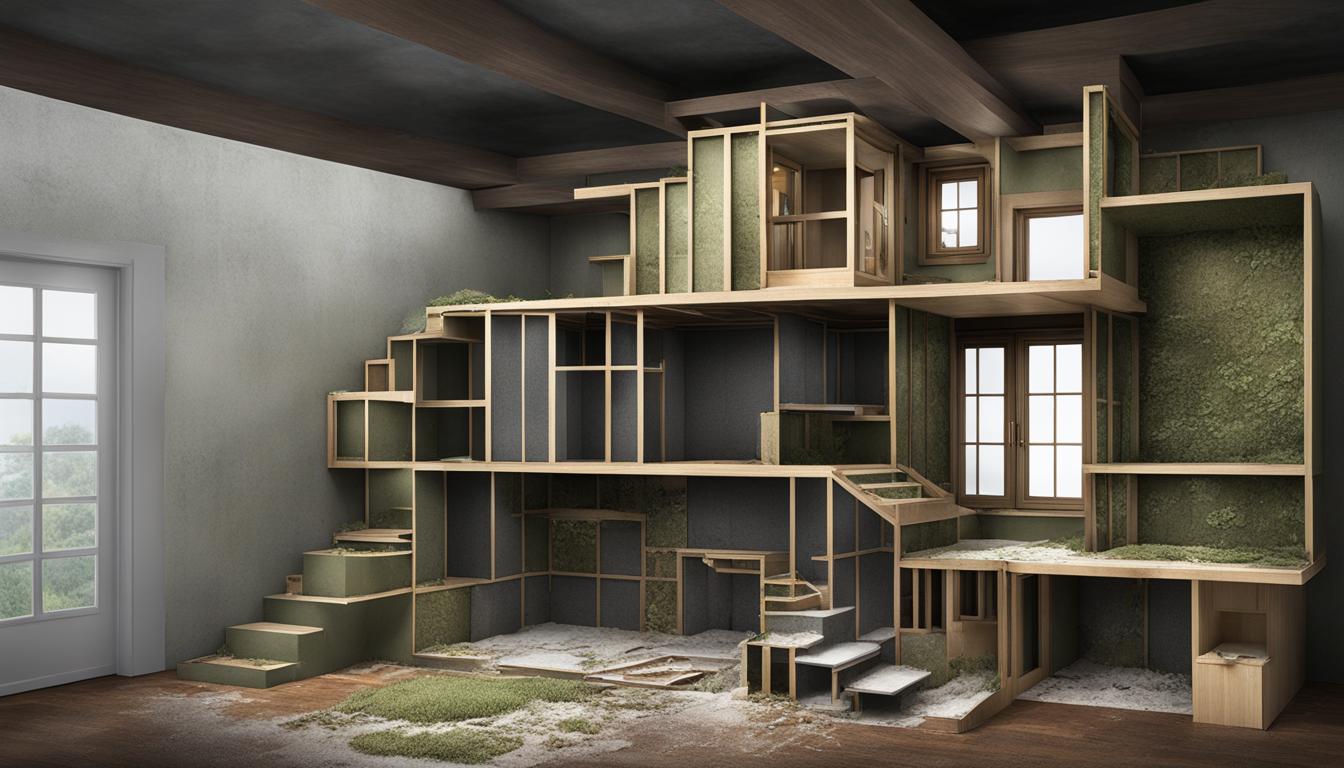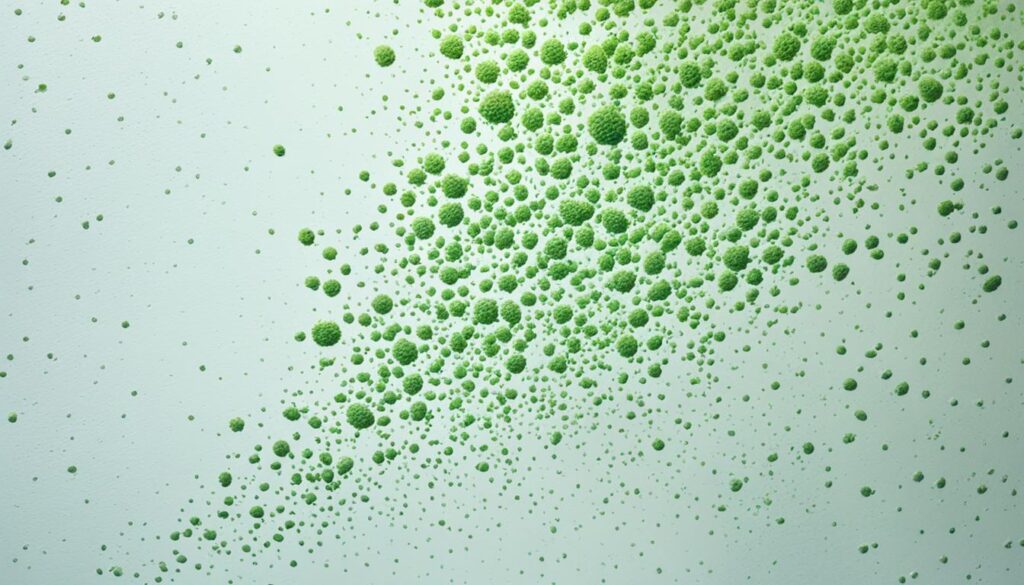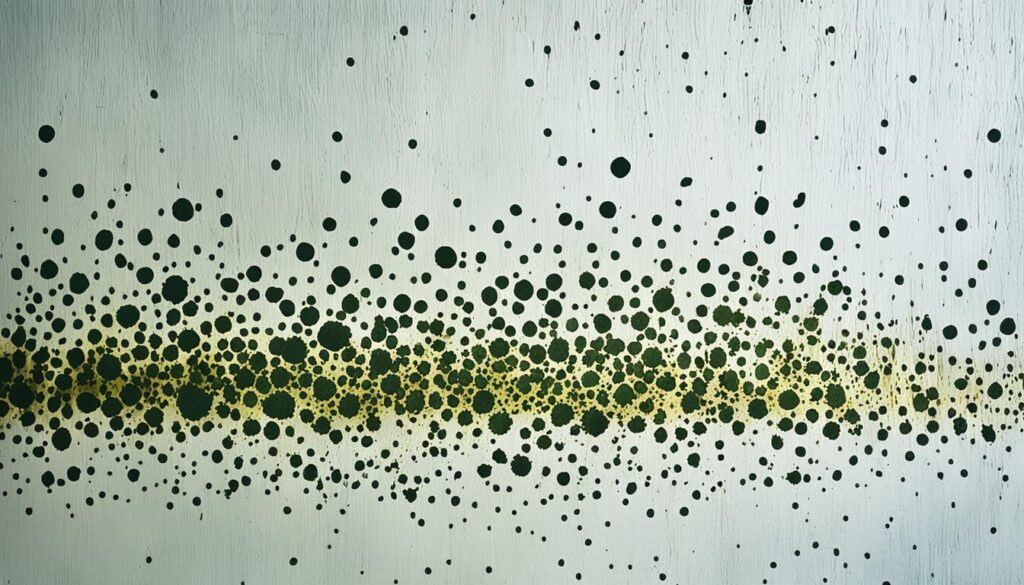
Understanding Sealed Mold Risks in Walls
Sealed mold inside a wall can pose significant health concerns and risks. Mold growth in walls is not always visible to the naked eye, making it a hidden danger that can impact indoor air quality and overall well-being. The presence of mold in walls can lead to a variety of health effects, ranging from respiratory issues to allergic reactions. It is essential to recognize the signs of sealed mold and take prompt action to address the problem.
In this article, we will explore the health implications associated with sealed mold inside walls. We will discuss the hidden dangers of sealed mold, including the potential health effects and risks that can arise from exposure. Additionally, we will examine how mold growth in walls can compromise indoor air quality and pose hazards to our health.
Key Takeaways:
- Sealed mold inside walls can have detrimental effects on indoor air quality and overall well-being.
- Mold growth in walls is often hidden and not visible to the naked eye, making it a hidden danger.
- Exposure to sealed mold can lead to various health issues, including respiratory problems and allergic reactions.
- Recognizing the signs of mold in walls is important for prompt action to mitigate health risks.
- Seeking professional assessment and remediation services is crucial to safely address sealed mold in walls.
The Hidden Dangers of Sealed Mold
When it comes to mold growth in our homes, the dangers extend beyond what meets the eye. Sealed mold inside walls poses a significant risk to both our health and the structural integrity of our living spaces. Unfortunately, this hidden mold can go unnoticed for extended periods, resulting in prolonged exposure and potential health complications.
Hidden mold dangers lie in the fact that it often grows unbeknownst to homeowners, concealed behind walls, wallpaper, or paneling. This invisibility makes it difficult to detect, leaving individuals vulnerable to the adverse effects of prolonged exposure. Without proper identification and remediation, the risks of sealed mold in a wall can be far-reaching.
“Hidden mold inside walls poses a significant risk to both our health and the structural integrity of our living spaces.”
The health effects of hidden mold can vary depending on an individual’s sensitivity and duration of exposure. Some common health risks associated with sealed mold include:
- Respiratory issues such as coughing, wheezing, and shortness of breath
- Allergic reactions, including nasal congestion, sneezing, and skin irritation
- Headaches, fatigue, and difficulty concentrating
- Exacerbation of asthma symptoms
- Increased susceptibility to respiratory infections
These health effects can be particularly concerning for individuals with pre-existing respiratory conditions or weakened immune systems. Additionally, prolonged exposure to hidden mold can lead to more severe health complications, making it crucial to address the issue promptly.
To get a deeper understanding of the risks of sealed mold in a wall, let’s take a look at the potential consequences in the table below:
| Health Risks | Effects on Individuals |
|---|---|
| Respiratory issues | Individuals may experience coughing, wheezing, and shortness of breath. |
| Allergic reactions | Symptoms may include nasal congestion, sneezing, and skin irritation. |
| Headaches and fatigue | Exposure to hidden mold can cause persistent headaches, fatigue, and difficulty concentrating. |
| Aggravation of asthma | People with asthma may experience a worsening of their symptoms upon exposure to sealed mold in walls. |
| Increased susceptibility to infections | Individuals exposed to hidden mold may be more prone to respiratory infections. |
It is important to keep in mind that the risks mentioned above are not exhaustive, and the consequences of hidden mold can vary depending on the specific circumstances and individual health factors. Therefore, seeking professional assistance and remediation services is crucial to mitigate these risks and ensure a safe living environment.
Understanding the Impact
The exposure to sealed mold in walls can have a significant impact on indoor air quality, contributing to an unhealthy living environment. In the next section, we will explore how sealed mold affects the air we breathe and the health implications it poses.
Impact on Indoor Air Quality
Sealed mold in walls can have a significant impact on indoor air quality, posing risks to our health and well-being. When mold grows in hidden areas, such as behind walls, it can release spores and mycotoxins into the air we breathe, leading to various health hazards.
Indoor mold exposure risks:
- Inhalation of mold spores can trigger respiratory problems, especially in individuals with pre-existing conditions such as asthma or allergies.
- Prolonged exposure to mold can cause symptoms such as coughing, wheezing, and nasal congestion.
- Mold exposure may also contribute to the development of respiratory infections.
Mold in walls health hazards:
- When mold spores become airborne, they can travel throughout the indoor environment, affecting not only the room with the mold but also other areas of the property.
- As mold continues to grow and spread, it can compromise the air quality in our homes, leading to a range of respiratory issues and allergic reactions.
- Exposure to mold can also aggravate existing conditions, impede the healing process, and reduce overall indoor air quality.
Sealed mold inside walls presents unique challenges as it may go unnoticed for extended periods, allowing it to worsen and further contaminate the air. This underscores the importance of prompt detection and remediation to prevent further health implications.
Understanding Sealed Mold Health Implications
Sealed mold can affect different individuals in various ways, with some experiencing more severe symptoms than others. The specific health effects can depend on factors such as the type of mold present, the concentration of spores in the air, and an individual’s sensitivity.
“When mold spores become airborne, they can travel throughout the indoor environment, affecting not only the room with the mold but also other areas of the property.”
It is essential to approach sealed mold exposure with caution and prioritize both prevention and remediation. By maintaining a healthy indoor environment and promptly addressing any signs of mold growth in walls, we can mitigate the potential health risks associated with sealed mold.

| Inhaling Mold Spores | Compromised Indoor Air Quality | Respiratory Issues |
|---|---|---|
| Mold spores released by sealed mold can be inhaled, posing risks to respiratory health. | Sealed mold contaminates the air, leading to a decrease in overall indoor air quality. | Prolonged exposure to mold can result in respiratory problems and exacerbate existing conditions like asthma and allergies. |
| Individuals with pre-existing respiratory conditions may experience worsened symptoms, including coughing and wheezing. | Persistent exposure to sealed mold can cause allergic reactions and respiratory infections. | Mold exposure may impede the healing process and contribute to the development of respiratory infections. |
| The concentration of mold spores inhaled and an individual’s sensitivity can impact the severity of health effects. | Sealed mold inside walls can compromise the air quality throughout the property, affecting occupants in various rooms. | The specific health implications can vary, depending on factors such as the type of mold present and the concentration of spores. |
Recognizing the Signs of Sealed Mold
Recognizing the signs of sealed mold in walls is essential for addressing the potential health risks associated with its presence. Mold growth behind walls may not always be visible, making it crucial to be aware of common indicators that mold may be present.
Here are some key signs to look out for:
- Musty odor: A persistent musty or earthy smell in a specific area of your home could indicate hidden mold behind walls.
- Visible water damage: Stains, discoloration, or peeling paint on walls, ceilings, or floors may suggest water infiltration and potential mold growth out of sight.
If you notice any of these signs, it is important to take prompt action to address the potential mold problem. Mold in walls can pose health risks and compromise indoor air quality, leading to respiratory issues and other health concerns.
Ignoring the signs of sealed mold can exacerbate the situation, potentially causing further damage to your health and property.
To ensure accurate detection and proper remediation, it is best to consult a professional mold inspection and remediation service. These experts have the necessary skills and experience to identify hidden mold, assess the extent of the damage, and implement effective remediation strategies.
Why Prompt Action Matters
Addressing the presence of sealed mold in walls promptly is crucial due to the potential health risks it poses. Mold spores can become airborne and circulate throughout your home, leading to respiratory issues, allergies, and other adverse health effects.
Moreover, mold growth can continue to spread if left untreated, causing further damage to the structural integrity of your walls and increasing the cost of remediation.
By taking immediate action to address sealed mold, you can safeguard your well-being and prevent further complications.

| Potential Signs of Sealed Mold | Actions to Take |
|---|---|
| Musty odor in specific areas | Contact a professional mold inspection service to assess and remediate the issue. |
| Visible water damage, stains, or discoloration | Inspect for potential mold growth behind the walls and seek professional remediation if needed. |
The Importance of Professional Assessment and Remediation
When it comes to dealing with sealed mold in walls, seeking professional assessment and remediation services is of utmost importance. While it may be tempting to handle the issue yourself, relying on experts can help ensure that the mold is identified, assessed, and safely removed, mitigating potential health risks.
Mold in walls poses significant health risks that should not be underestimated. The hidden nature of mold growth means that it often goes unnoticed, allowing it to multiply and spread throughout the wall cavity. Without proper assessment and remediation, this hidden mold can have severe health effects on the occupants of the building.
Professional mold assessors have the expertise and tools to accurately detect the presence of hidden mold. They use specialized equipment such as moisture meters and thermal imaging to identify areas of moisture buildup behind walls. By pinpointing the source and extent of mold growth, professionals can develop an effective remediation plan.
Remediation experts follow industry best practices to safely remove mold from walls. They use containment measures to prevent the spread of mold spores during the removal process and employ appropriate personal protective equipment to ensure their own safety and the safety of others. Professional remediation helps eliminate the mold problem at its root, reducing the chances of recurrence.
“Professional assessment and remediation services are crucial for addressing sealed mold in walls. The expertise and experience of professionals ensure that the mold problem is effectively resolved, reducing health risks and improving indoor air quality.”
By hiring professionals, you can have confidence in the thoroughness of the mold assessment and remediation process. They will not only identify and remove the visible mold but also address the underlying moisture issue that led to mold growth. This comprehensive approach helps prevent future mold problems, protecting the health and well-being of your household or occupants.
The Benefits of Professional Assessment and Remediation
Here are some key benefits of relying on professionals for sealed mold in walls:
- Accurate Detection: Professionals have the knowledge and tools to accurately detect hidden mold, ensuring that all affected areas are identified and addressed.
- Safe Removal: Experts follow industry standards to safely remove mold, minimizing the risk of mold spore exposure during the remediation process.
- Prevention of Further Damage: Professional assessment helps identify the underlying causes of mold growth, allowing for effective preventative measures to be put in place.
- Improved Indoor Air Quality: Proper remediation eliminates mold and restores indoor air quality, reducing the risk of respiratory issues and other health problems.
- Peace of Mind: By entrusting the mold assessment and removal to professionals, you can have peace of mind knowing that the job is being handled by experienced experts.
When it comes to sealed mold in walls, taking swift action and entrusting the task to professionals is crucial for protecting your health and the health of others. Don’t underestimate the potential health effects of hidden mold. Contact a reputable mold assessment and remediation service today to ensure a safe and mold-free indoor environment.
Preventive Measures and Maintenance
To minimize the risk of sealed mold in walls and mitigate the potential health hazards associated with hidden mold, implementing preventive measures and practicing regular maintenance is crucial. By taking proactive steps, you can create a healthier indoor environment and protect yourself and your loved ones from the health effects of mold.
1. Keeping Walls Dry
One of the most effective ways to prevent mold growth is by keeping the walls in your home dry. Moisture is the primary catalyst for mold development, so it’s important to address any sources of water or dampness promptly. Regularly inspect your walls for signs of leaks, plumbing issues, or condensation and resolve them immediately. Additionally, ensure proper ventilation in high-moisture areas like bathrooms and kitchens to minimize excess humidity.
2. Controlling Humidity Levels
Maintaining optimal humidity levels is essential in preventing mold growth. The ideal range is below 50% humidity. Invest in a dehumidifier to control moisture levels, particularly in areas prone to humidity, such as basements and crawl spaces. Monitor and adjust the humidity settings accordingly to prevent excess dampness, which can create an ideal environment for mold to thrive.
3. Proper Insulation and Ventilation
Insulating your walls and ensuring proper ventilation throughout your home is key to reducing the risk of sealed mold. Good insulation helps prevent condensation by maintaining consistent temperatures and minimizing temperature fluctuations, which can lead to moisture buildup. Adequate ventilation, such as exhaust fans in bathrooms and kitchens, helps remove excess moisture and improve airflow, reducing the chances of mold growth.
4. Regular Cleaning and Maintenance
Regular cleaning and maintenance can help detect and address mold growth early on. Routinely inspect your walls for any visible signs of mold, such as discoloration or musty odors. If you spot any signs, promptly address the issue by contacting a professional mold remediation service. Additionally, clean and disinfect surfaces regularly, especially in areas prone to moisture, to prevent the accumulation of mold spores.
“Prevention is always better than cure. By implementing these preventive measures and practicing regular maintenance, you can significantly reduce the risk of sealed mold in your walls and protect your health.”
Remember, taking a proactive approach to prevent mold growth is essential for safeguarding your home and well-being. By keeping your walls dry, controlling humidity levels, ensuring proper insulation and ventilation, and practicing regular cleaning and maintenance, you can minimize the risk of sealed mold and the associated health effects.
Conclusion
In conclusion, understanding the risks associated with sealed mold in walls is crucial for maintaining a healthy indoor environment. Sealed mold can have adverse effects on both air quality and overall well-being, making it important to address any signs of mold growth promptly. By recognizing common indicators and seeking professional assessment and remediation services, individuals can mitigate the potential health effects of hidden and sealed mold.
Professional assessment and remediation play a vital role in effectively dealing with sealed mold in walls. Trained experts have the knowledge and tools to identify and safely remove mold, minimizing health risks and preventing further damage. Their expertise ensures that the remediation process is thorough and effective, restoring the indoor environment to a mold-free state.
Prevention is also key in reducing the risk of sealed mold in walls. By implementing preventive measures and proper maintenance strategies, individuals can create an environment that is inhospitable to mold growth. Keeping walls dry and addressing any water leaks or moisture issues promptly can go a long way in preventing mold from taking hold.
If you suspect sealed mold in your walls and require professional assessment and remediation services, contact Fix Mold Miami at 305-465-6653. Their team of experts is well-equipped to handle mold-related issues and help ensure a healthy indoor environment for you and your loved ones.




